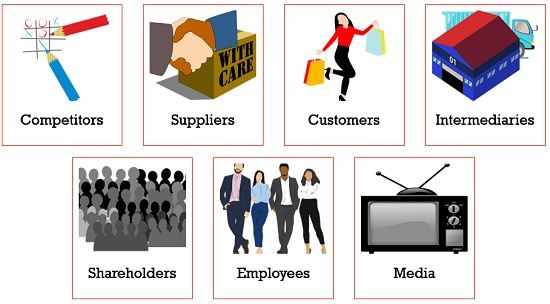Definition: Micro Environment, refers to the environment comprising of all the actors of an organization’s immediate environment which influences the performance of the company, as they have a direct bearing on the firm’s regular business operations.
The micro environment is popularly referred to as task environment or operating environment.
Elements of Micro Environment
The elements of the micro environment are closely associated with the company and they do not affect all the companies operating in the industry, in a similar manner, as some factors are specific to the firm.
So we can say that the micro environment is one which the firm addresses in its specific arena, such as the industry or the strategic group.
Given below are some important elements of micro environment:
Competitors
Competition is what keeps the firm thriving. Competitors are the rival sellers operating in the same industry. It must be noted that the nature and intensity of competition highly influence the firm’s products and services. Product Differentiation is something that helps the firm to beat the cut-throat competition in the market.
For a firm to survive competition it is required to keep a close watch on the competitors (both existing and potential) future moves and actions, so as to prepare in advance, as well as to predict the response of competitors to company’s moves. Moreover, competitor analysis also helps in maintaining or improving market share and position.
Suppliers
Suppliers are the one who provides inputs such as material, components, labour and other stock of goods to the firm, which is required to undertake manufacturing activities. when there is uncertainty as to the supply constraints, it usually builds pressure on the firms and they are required to maintain high inventories, which leads to cost increases.
Suppliers have the power to change the firm’s position in the market and its capabilities.
The relationship amidst the firm and its suppliers represents a power equation, based on the industry conditions and their dependence on each other.
Customers
The success of the organization greatly depends on how effectively the firm fulfils the needs and wants of the customers, which is profitable to the firm and also provides value to the customer. The firm needs to analyze what the customers expect from their products and services so that the firm can satisfy them.
It must be noted that without customers no business can survive for a long time. So, the primary objective of the firm is to create and retain customers, to keep itself going.
Intermediaries
Intermediaries refer to marketing intermediaries which cover agents, merchants, distributors, dealers, wholesalers, etc. that participate in the company’s supply chain, in stocking and transporting the goods from their source location to their destination.
It acts as a link between the business organization and the ultimate consumer.
Shareholders
Shareholders are the real owners of the company who invest their money in the company’s business, by purchasing the shares, for which they are paid a dividend every year as a return. Shareholders have the right to vote in the company’s general meeting.
Employees
Placing the right person at the right job and retaining them for the long term by keeping the staff motivated is very important for the strategic planning process. Training and development act as a guide to the firm’s employees which ensures an up-to-date workforce.
A qualified and competent workforce can help the firm to achieve success with little efforts.
Media
We all know the power of media these days, it can make or break an organization or its products/services overnight.
Management of media whether electronic media, press media or social media is really important not just to create a positive and clean image of the company and its products in front of the audience but also to support the firm in building a good reputation in the market. The right use of media can do wonders for the company and boost its sales.
When the firm competes with the firm operating in the same industry, with the same micro environmental factors, the relative success of the company is based on the relative effectiveness of the company in dealing with these factors.

Kwanele says
Who is the author of this article and when was it published?
Surbhi S says
The author of this article is Surbhi S. and it was published on Feb 14, 2020
Jorge Morais Diamantino says
THANKS FOR THIS
Aneta says
Thank you very much!
harry machamanda says
great explanation
Heather Mpala says
Thank you for helping us understand business jargons
sema crist says
NICE
Sodia Saunta says
I like this video
m.dokata says
thank you for great support keep it up